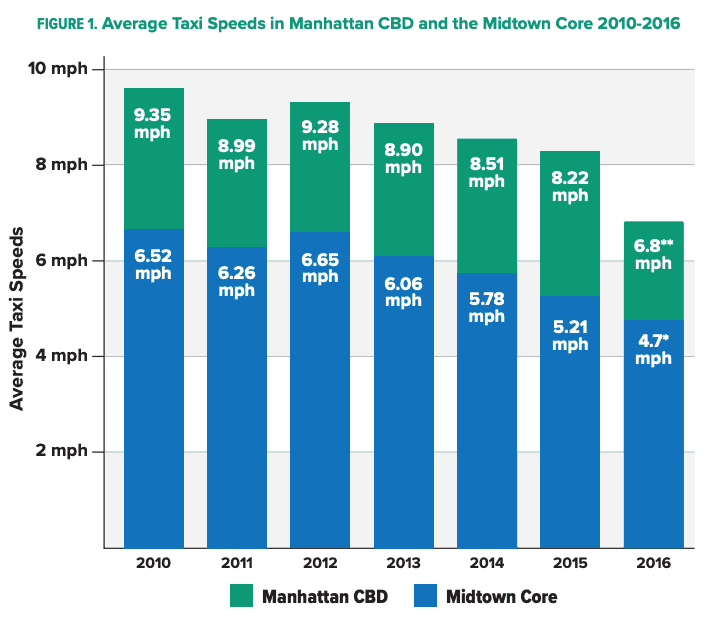Big Apple’s traffic is rotten to the core thanks to rise of on-demand economy; congestion pricing may be cure, but uncertainties abound.
New York’s plan to toll vehicles entering the lower third of Manhattan is the unintended consequence of two of the hottest trends in transportation right now – ride-sharing and on-demand delivery.
Companies in those sectors will bear yet another cost for operating in one of the most expensive U.S. cities. But if it can speed traffic, it may yet be worth it, one expert said.
The New York State Legislature’s just-passed budget for the next fiscal year includes a provision for tolling all vehicles that enter the borough of Manhattan below 60th Street. Governor Andrew Cuomo is expected to sign the budget into law.
The “central business district tolling program” would be the first attempt by a U.S. city to put a price on traffic, said Nicole Gelinas, a senior fellow focusing on transportation issues at the Manhattan Institute. She says estimates are that about 700,000 vehicles enter downtown Manhattan every day.
Congestion pricing, already a tool in use in European cities, was first pitched by former Mayor Michael Bloomberg in 2007 as a way to relieve gridlock in downtown New York City and raise funds for the city’s subway system, which is badly in need of repairs.
“The theory of congestion pricing is perfectly sound as it recognizes we have a finite set of streets available to use,” Gelinas said. “A lot here is going to hinge on how it is implemented.”
How it will be implemented is the risk now facing transportation companies, said Kendra Hems, president of the New York State Motor Truck Association.
“There are a lot of unanswered questions,” she said.
The latest effort at congestion pricing stems from the Fix NYC panel convened in 2017 by Governor Cuomo. It found New York City to be the third most congested city in the world, with average taxi speeds in the central business district dropping from over nine miles per hour in 2010 to just below seven miles per hour in 2016. In the most crowded center of New York, walking is the fastest option.

“Traffic congestion in Manhattan has long been a defining feature of our city, but over the past few years, the gridlock caused by congestion has become more impactful on daily life,” the panel said in a report. “The periods of time during which (traffic) seems to grind to a halt last longer and occur more frequently throughout the day.”
The panel cited both increased pedestrian and commercial vehicle traffic as reasons for the deteriorating traffic velocity. Pedestrian traffic, which rose by one-quarter from 2009 to 2015, “slows traffic, increases congestion and obstructs vehicles attempting to turn corners at crowded crosswalks.”
Ride-hailing firms such as Uber and Lyft (Nasdaq: LYFT) were also called out for increasing congestion. Even as taxi traffic fell, ride-hailing apps added 202,000 trips into Manhattan in 2017, up from zero four years earlier, which “contributed significantly to recent congestion spikes,” the panel found.
To this mix is added the growing number of vehicles roaming the city associated with e-commerce and on-demand delivery services – from Amazon (Nasdaq: AMZN), UPS (NYSE: UPS), FedEx( NYSE: FDX) to Fresh Direct. The panel forecasts a 46 percent rise in freight tonnage through 2040 due to “additional truck deliveries and through trips.”
The tolling program is scant on details, so it’s not clear how it will impact commercial transportation firms, Hems said. She says that commercial freight vehicles from straight trucks on up to five-axle trucks account for 8 percent of traffic in all five boroughs of New York.
The state’s public transit board, the Metropolitan Transportation Authority, will convene a panel by the end of 2020 to make recommendations for how the program will work once it begins in 2021.
Trucks already face some of the highest tolls in the nation for entering Manhattan via the city’s bridges and tunnels. The legislation did not carve out any exemption or credit for trucks already paying those tolls, Hems said. Her group plans to start educating legislators on the impact to the trucking industry.
“We don’t know what the toll is going to be and whether there will be concessions for bridge tolls,” Hems said.
Manhattan Institute’s Gelinas said the advisory panel may likely follow the advice of Fix NYC and propose a roughly $25 toll on commercial vehicles entering downtown Manhattan. But other aspects of the new legislation still present big uncertainties.
As currently worded, the tolls would be applied to vehicles “entering or remaining” in downtown Manhattan. Gelinas said that could mean a one-time toll assessed upon entering the toll zone. Or it could mean a toll being assessed for vehicle-miles travelled inside the zone, which would have a big impact on delivery and parcel services.
But the tolls for transporting people and goods in downtown New York could be offset by the efficiency gains should congestion drop, Gelinas said. Parcel companies operating in New York City face nearly $200 million in parking tickets, partially due to street congestion impeding traffic.
“The question is will the state and city get this right so that it reduces congestion?” Gelinas said. “If they do and it cuts down the number of hours a driver is on the road then it’s okay. But if it doesn’t then it’s just another tax.”











